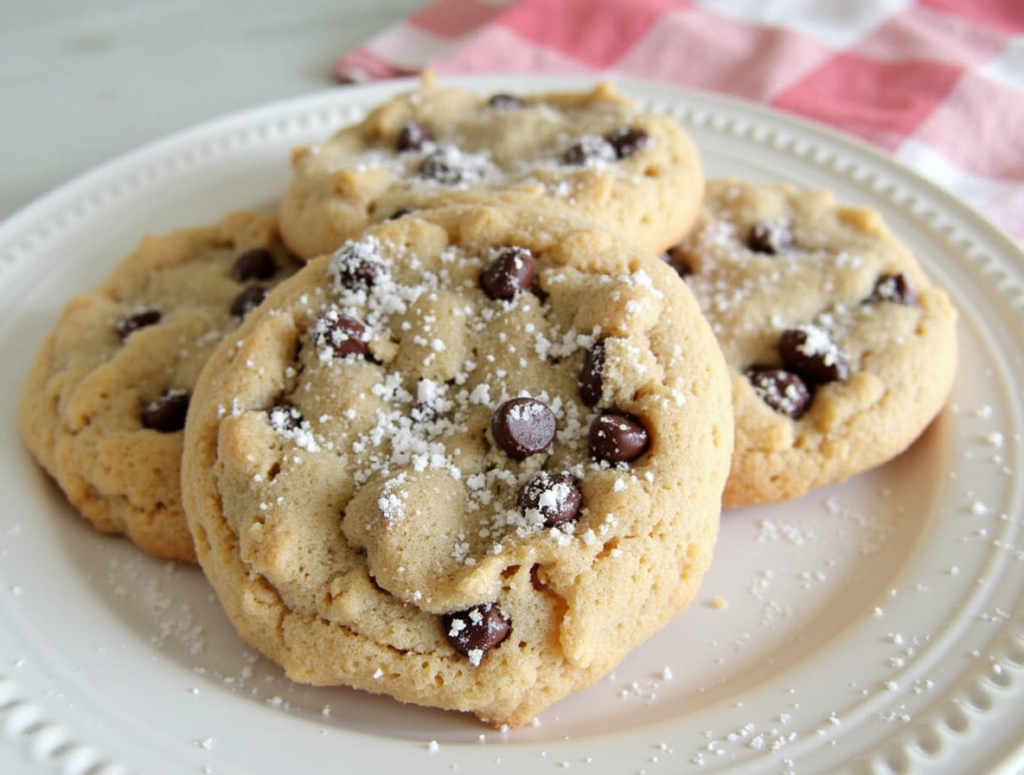Chocolate Chip Cookies with Powdered Sugar
Table of Contents
There’s something undeniably magical about biting into a warm, freshly baked chocolate chip cookie. The combination of rich chocolate, a slight crispness on the outside, and a chewy center is a universal comfort. But have you ever wondered if there’s a way to take your chocolate chip cookies to the next level? You might have heard of using powdered sugar in place of granulated sugar.
While this seems like a minor change, it actually has a significant impact on both the texture and taste of your cookies. So, if you’re looking to create the perfect batch of cookies that melt in your mouth and leave everyone asking for more, you’re in the right place. Let’s explore the differences that powdered sugar can make in your chocolate chip cookies.
The Science of Sugar in Baking
To understand the difference powdered sugar can make in your cookies, it’s important to first know how sugar works in baking. Sugar isn’t just there to make things sweet; it plays a crucial role in how your cookies turn out. Whether you use granulated, powdered, or brown sugar, each type behaves a little differently.
Granulated Sugar: The Standard Choice
Granulated sugar is the go-to sugar for most cookie recipes. It helps cookies spread evenly during baking, contributing to a crisper texture. When combined with butter, granulated sugar forms air pockets that help your dough rise, giving the cookies structure and chewiness. It also promotes browning by drawing moisture out of the dough.

Powdered Sugar: A Softening Agent
Powdered sugar, or confectioners’ sugar, is finely ground sugar mixed with a small amount of cornstarch. The cornstarch helps absorb moisture, which is why powdered sugar creates a softer, more tender texture when used in baking. Unlike granulated sugar, powdered sugar doesn’t cause as much spread during baking, leading to a denser, cake-like consistency in your cookies.
In summary, while both sugars provide sweetness, they affect the dough in different ways. Granulated sugar creates crisp edges and chewiness, while powdered sugar softens the dough and adds a delicate, melt-in-your-mouth texture.
What Happens When You Use Powdered Sugar in Chocolate Chip Cookies?
When you swap out the traditional granulated sugar for powdered sugar in your chocolate chip cookie recipe, you’re making a subtle yet impactful change. Let’s break down the main differences that occur in both texture and taste.
Texture: Soft and Delicate
The most noticeable change when using powdered sugar is the texture of the cookies. Granulated sugar helps create a crisp, firm edge on your cookies, with a slight chew in the middle. However, powdered sugar leads to a much softer result. This is because powdered sugar, mixed with the cornstarch, prevents gluten from developing as much during mixing, which would normally give the cookies structure. The result is a lighter, airier cookie with a more cake-like crumb that melts in your mouth.
Taste: Subtle Sweetness
Because powdered sugar is finely ground, it dissolves more easily into the dough, resulting in a smoother and more even sweetness. The sweetness from powdered sugar is often more subtle than that from granulated sugar, as it doesn’t create as much contrast between the sweet and salty elements in the dough. This makes for a richer, rounder flavor without the overt sweetness that granulated sugar might bring.
Additionally, the cornstarch in powdered sugar slightly dulls the sweetness, making it taste more refined. If you’re looking for a cookie with a smooth, delicate sweetness that doesn’t overpower your taste buds, powdered sugar may be the key.
Chewier and Softer: A New Experience
When using powdered sugar, your cookies will likely be thicker, softer, and slightly chewier, which might remind you more of shortbread. This change in texture can make a big difference in how the cookies feel when you eat them. If you prefer cookies that aren’t too crisp or crunchy, swapping in powdered sugar will be a great option.
Recipe Comparison: Traditional vs. Powdered Sugar Cookies
The best way to truly understand the impact of powdered sugar is by comparing two similar recipes: one made with granulated sugar and the other with powdered sugar. Let’s look at how the ingredients and methods differ between the two versions.
Traditional Chocolate Chip Cookies (Granulated Sugar)
| Ingredient | Amount |
| All-purpose flour | 2 ½ cups |
| Granulated sugar | 1 cup |
| Unsalted butter | 1 cup |
| Vanilla extract | 1 tsp |
| Baking soda | 1 tsp |
| Semi-sweet chocolate chips | 1 ½ cups |
| Eggs | 2 large |
| Salt | ½ tsp |
Chocolate Chip Cookies with Powdered Sugar
| Ingredient | Amount |
| All-purpose flour | 2 ½ cups |
| Powdered sugar | 1 cup |
| Unsalted butter | 1 cup |
| Vanilla extract | 1 tsp |
| Baking soda | 1 tsp |
| Semi-sweet chocolate chips | 1 ½ cups |
| Eggs | 2 large |
| Salt | ½ tsp |
Directions for Both Recipes:
- Begin by preheating your oven to 350°F (175°C) and preparing a baking sheet with a layer of parchment paper.
- Next, beat the butter and sugar together until the mixture becomes light, airy, and smooth.
- For the traditional recipe, use granulated sugar. For the powdered sugar version, beat the powdered sugar and butter until smooth.
- Incorporate the eggs and vanilla extract, mixing thoroughly after each addition until the batter is well combined.
- Mix in the dry ingredients, including flour, baking soda, and salt. Fold in the chocolate chips.
- Drop spoonfuls of dough onto the prepared baking sheet, ensuring each cookie is spaced about 2 inches apart. Bake for 10 to 12 minutes, or until the edges are golden and the centers are set. Allow the cookies to cool on a wire rack before indulging in the delicious results.
Key Differences:
- Granulated sugar helps the cookies spread more during baking, creating crisp edges and a chewy center.
- Powdered sugar makes for a thicker, puffier cookie that’s softer and has a more tender texture.
Tips for Perfect Chocolate Chip Cookies with Powdered Sugar
When you’re baking chocolate chip cookies with powdered sugar, there are a few tricks that can help you get the best results. Here’s how to make sure your cookies turn out perfectly every time.
1. Measure Accurately
Since powdered sugar is lighter than granulated sugar, it’s important to measure it properly. Use a spoon to fill your measuring cup and level it off, rather than packing it down. Too much powdered sugar can make the dough too dense, resulting in a thicker, less chewy cookie.
2. Chill the Dough
Chilling your cookie dough for at least 30 minutes before baking helps the cookies maintain their shape and enhances the flavor. Skipping this step may cause your cookies to spread excessively, resulting in a thinner texture.
3. Don’t Overmix
When you add the dry ingredients to the wet, mix just until everything is combined. Overmixing can cause the cookies to become tough, especially since powdered sugar prevents as much gluten development as granulated sugar. Limit the mixing to avoid overworking the dough, ensuring the best possible texture.
4. Use Quality Chocolate Chips
The chocolate chips you choose can make a huge difference in the final taste. Go for high-quality semi-sweet or dark chocolate chips to create a rich contrast to the sweetness of the powdered sugar dough. This will elevate the flavor of your cookies.
Frequently Asked Questions (FAQ)
Can I substitute powdered sugar for granulated sugar in any cookie recipe?
While you can substitute powdered sugar for granulated sugar in most cookie recipes, it’s important to understand that the texture and spread of the cookies will change. Powdered sugar will yield a softer, thicker cookie. You may need to adjust the amount of flour and baking time to get the desired consistency.
Does powdered sugar affect the cookie’s shelf life?
Yes, powdered sugar can affect the shelf life of your cookies. Because powdered sugar adds moisture to the dough, cookies made with it may stay softer for a longer period. However, they could become soggy if stored in a humid environment. To ensure freshness, store your cookies in an airtight container at room temperature.
How does the cornstarch in powdered sugar change the recipe?
The cornstarch in powdered sugar helps reduce the gluten formation in the dough, resulting in a softer, more delicate texture. This makes the cookies more tender and crumbly, similar to shortbread, compared to the more traditional chewy texture created with granulated sugar.
Conclusion: The Sweet Choice is Yours
Now that you know how powdered sugar affects both the texture and taste of your chocolate chip cookies, it’s time to give it a try. If you’re craving a soft, melt-in-your-mouth cookie with a refined sweetness, powdered sugar might just be your new secret ingredient. Whether you’re baking for yourself, your family, or a special occasion, this simple swap can elevate your cookie game to a whole new level.
So, what are you waiting for? Gather your ingredients, set your oven to preheat, and begin baking. Don’t forget to share your creations with friends and family—they’re going to love the new twist on a classic treat!

